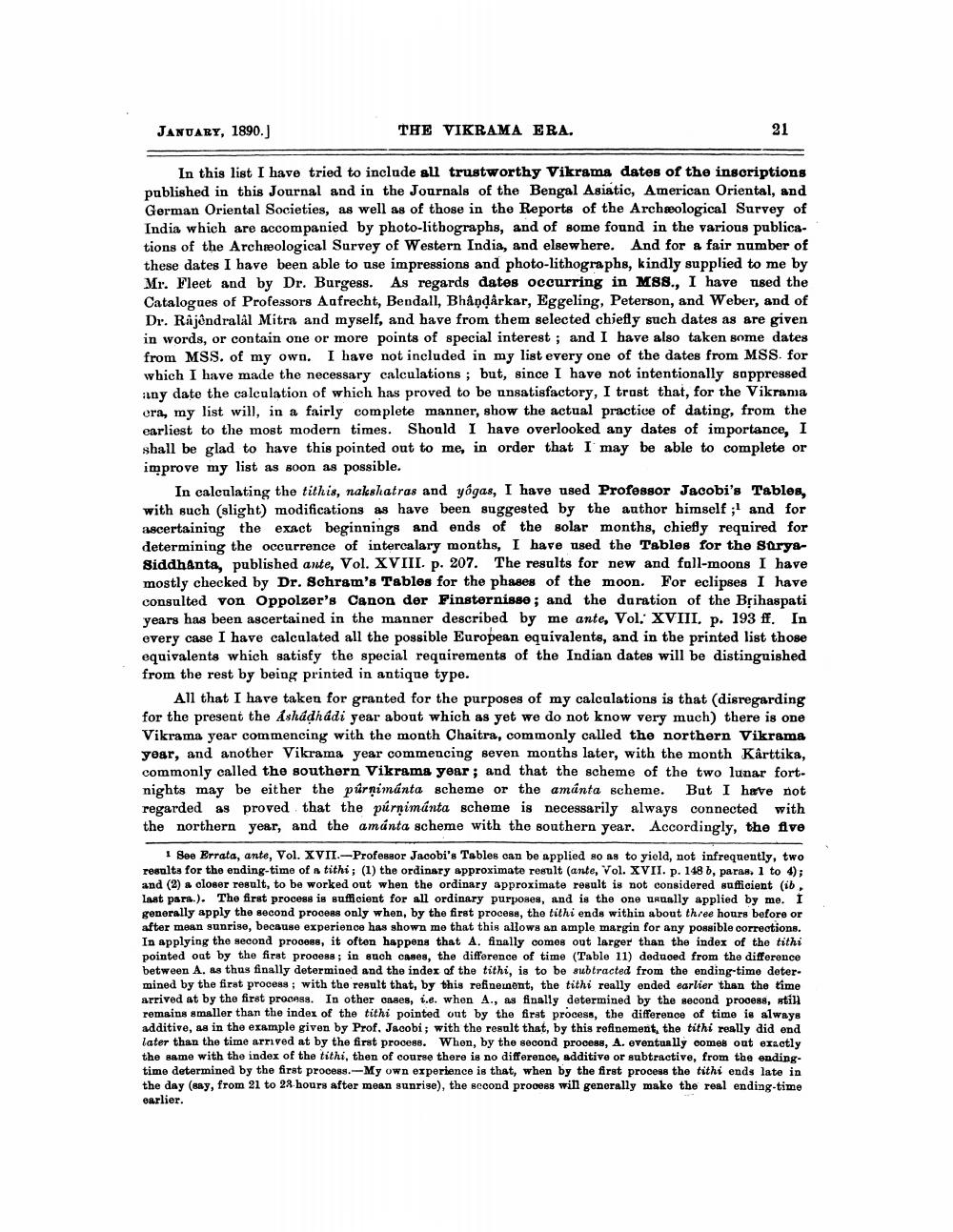________________
JANUARY, 1890.]
THE VIKRAMA ERA.
21
In this list I have tried to include all trustworthy Vikrams dates of the inscriptions published in this Journal and in the Journals of the Bengal Asiatic, American Oriental, and German Oriental Societies, as well as of those in the Reports of the Archeological Survey of India which are accompanied by photo-lithographs, and of some found in the various publications of the Archeological Survey of Western India, and elsewhere. And for a fair number of these dates I have been able to use impressions and photo-lithographs, kindly supplied to me by Mr. Fleet and by Dr. Burgess. As regards dates occurring in M88., I have used the Catalogues of Professors Aafrecht, Bendall, Bhåņdårkar, Eggeling, Peterson, and Weber, and of Dr. Rajøndralâl Mitra and myself, and have from them selected chiefly such dates as are given in words, or contain one or more points of special interest ; and I have also taken some dates from MSS. of my own. I have not included in my list every one of the dates from MSS. for which I have made the necessary calculations ; but, since I have not intentionally soppressed any date the calculation of which has proved to be ansatisfactory, I trust that, for the Vikrama era, my list will, in a fairly complete manner, show the actual practice of dating, from the earliest to the most modern times. Should I have overlooked any dates of importance, I shall be glad to have this pointed out to me, in order that I may be able to complete or improve my list as soon as possible.
In calculating the tithis, nakshatras and yôgas, I have used Professor Jacobi's Tables, with such (slight) modifications as have been suggested by the author himself ;1 and for ascertaining the exact beginnings and ends of the solar months, chiefly required for determining the occurrence of intercalary months, I have used the Tables for the SuryaSiddhanta, published ante, Vol. XVIII. p. 207. The results for new and fall-moons I have mostly checked by Dr. Schram's Tables for the phases of the moon. For eclipses I have consulted von Oppolzer's Canon der Finsternisse, and the duration of the Bțihaspati years has been ascertained in the manner described by me ante, Vol. XVIII, p. 193 ff. In every case I have calcalated all the possible European equivalents, and in the printed list those equivalents which satisfy the special requirements of the Indian dates will be distinguished from the rest by being printed in antique type.
All that I have taken for granted for the purposes of my calculations is that (disregarding for the present the Ashádhádi gear about which as yet we do not know very much) there is one Vikrama year commencing with the month Chaitra, commonly called the northern Vikrama year, and another Vikrama year commencing seven months later, with the month Kårttika, commonly called the southern Vikrama year; and that the scheme of the two lunar fort. nights may be either the púrnimánta scheme or the amánta scheme. But I have not regarded as proved that the púrnimánta scheme is necessarily always connected with the northern year, and the amánta scheme with the southern year. Accordingly, the five
See Errata, ante, Vol. XVII.-Professor Jacobi's Tables can be applied so as to yield, not infrequently, two results for the ending-time of a tithi; (1) the ordinary approximate result (ante, Vol. XVII. p. 148 6, paras, 1 to 4); and (2) a closer result, to be worked out when the ordinary approximate result is not considered sufficient (ib, last para.). The first process is sufficient for all ordinary purposes, and is the one usually applied by me. I generally apply the second process only when, by the first process, the tithi ends within about three hours before or after mean sunrise, because experience has shown me that this allows an ample margin for any possible corrections. In applying the second proces8, it often happens that A. finally comes out larger than the index of the tithi pointed out by the first process; in such cases, the difference of time (Table 11) deduced from the difference between A. as thus finally determined and the index of the tithi, is to be subtracted from the ending-time determined by the first process; with the result that, by this refinement, the tithi really ended earlier than the time arrived at by the first process. In other cases, i.e. when A., as finally determined by the second process, still romains smaller than the index of the tithi pointed out by the first process, the difference of time is always additive, as in the example given by Prof. Jacobi; with the result that, by this refinement, the tithi really did end later than the time arrived at by the first process. When, by the second process, A. eventually comes out exactly the same with the index of the tithi, then of course there is no difference, additive or subtractive, from the endingtime determined by the first process.--My own experience is that, when by the first process the tithi ends late in the day (say, from 21 to 22 hours after mean sunrise), the second process will generally make the real ending-time earlier.




